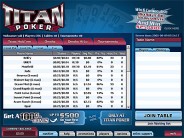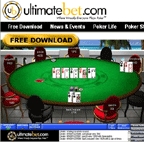Fancy Play Syndrome in Online Draw Poker
Fancy Play Syndrome (FPS), a term invented by Mike Caro, means choosing unusual tactics too frequently when the more obvious choices would do better. FPS often implies that a player goes out of his Michael Wiesenberg made his living playing poker for 10 years before turning to a career as a writer. His books include 'Free Money: How to Win in the Cardrooms of California'; 'The Dictonary of Poker', and 'The Ultimate Casino Guide. Check out his writings on everything online draw poker! way to impress opponents by using unexpected strategies that actually cost profits through overuse. My take on FPS is that it is wasted in low-limit games in which players generally aren’t even paying attention. This is particularly true in online draw poker.
Michael Wiesenberg made his living playing poker for 10 years before turning to a career as a writer. His books include 'Free Money: How to Win in the Cardrooms of California'; 'The Dictonary of Poker', and 'The Ultimate Casino Guide. Check out his writings on everything online draw poker! way to impress opponents by using unexpected strategies that actually cost profits through overuse. My take on FPS is that it is wasted in low-limit games in which players generally aren’t even paying attention. This is particularly true in online draw poker.
One reason FPS is wasted in online draw is that there are only two rounds. If you have a good hand, you want to get maximum money in the pot on both rounds. Slow-playing might be profitable sometimes in a game with four or five rounds of betting, but rarely in one with two. Another is that if the FPS is an elaborate bluff, it might work against sophisticated players in hold'em or stud who have several rounds in which to get out, but not in a two-round game in which players have shown a desire to play.
I wasn’t involved in this play. I certainly would have played it differently. This was in a five-handed $2-$4 game. YrralEsool was a loose-aggressive player who overvalued his hands. He had capped before the draw on three separate occasions with just a pair of aces, and then either bet or called after the draw against a hand that obviously — well, obvious to me — was better than one pair. Two of those times he lost to two pair and one of the times he made three aces and won a nice pot. The point, though, was that this was a guy who would never back off a hand. He had also capped after the draw with two pair against a one-card draw. When the one-card opponent, CallAllBets raised after the draw, it was clear — to me at least — that CallAllBets had made a complete hand. YrralEsool was fairly straightforward. He was not one of those tricky players who drew two cards to one pair and one card to trips. If he raised and drew two cards, he probably had trips. If he raise-opened, he clearly indicated he was interested in the pot.
On this play, YrralEsool raise-opened. I had a pair of queens. I folded. Against some players, in some situations, I might be in, but here I was pretty sure I was beat. CallAllBets called. SuitedAces777 folded on the button.
The small blind folded. It was Pierrot’s big blind. Pierrot is afflicted with FPS. I’ve seen him many times call with trips in the little blind when someone has raise-opened on the button. He then draws one card. If the opener takes three cards, Pierrot then bets to make it look like he was drawing to a straight or flush, missed, and is now bluffing. The opener reasons, incorrectly, that Pierrot would have reraised with trips and would not now be betting with two pair. If the opener takes two cards or one, he check-raises.
Okay. Back to this pot. Pierrot reraised. And I thought, “Aha. Trips.” YrralEsool reraised, capping the betting. That told me nothing other than that YrralEsool had at least a pair of aces. CallAllBets called. Pierrot called.
On the draw, Pierrot took one card, which further reinforced in my mind that he had trips. YrralEsool took two cards. He for sure had trips. CallAllBets took one card. He most likely had two pair, although he could be drawing to a straight or flush.
Pierrot bet out. This somewhat surprised me, because normally he would go for a check-raise. Predictably, YrralEsool raised. CallAllBets called. I was pretty sure he had two pair. He was clueless enough not to realize that YrralEsool had to have trips here, and Pierrot likely had at least that. Pierrot called.
Time for the showdown. Pierrot had 9-T-J-Q-K, a straight. YrralEsool and CallAllBets both folded without showing their cards. This I did not understand. Oh, I understood what YrralEsool and CallAllBets had and why they had called. What I did not understand was why Pierrot had failed to put in the third bet. He had to have CallAllBets beat, because CallAllBets would have himself raised YrralEsool’s raise if CallAllBets had made a complete hand. Therefore, Pierrot had only YrralEsool to worry about, and YrralEsool had demonstrated a willingness to cap after the draw with as good as two pair. A reraise here was guaranteed two more bets, maybe four.
Pierrot had totally wussed out, which is something I see regularly happen to FPSers. But he had made several atrocious mistakes. He had put in a third bet before the draw with just a drawing hand when he was getting at best 3-to-1 There was a good chance the pot would get reraised, so he was essentially going to have to put in three bets when his likely expectation was 11 bets if he made the hand, maybe 13. The odds against making the straight were 39-to-8, nearly 5-to-1. If he was drawing to T-J-Q-K, the odds might have been worse, because YrralEsool or CallAllBets could well have a pair of aces. The hand Pierrot showed down had three different suits, so he had not been drawing to a straight flush. And if he made the hand and it got beat, Pierrot was going to lose at least two bets after the draw. His implied odds weren’t anywhere near 5-to-1. But if he just called with a straight draw, the immediate pot odds were 5-to-1 and the implied odds higher. Clearly a call was a much better play. And what did he plan to do if he missed the hand? Sometimes your chances of winning improve by raising to draw to a straight or a flush because you can bluff if you miss, but not against these two. YrralEsool had shown an interest in the pot and CallAllBets would never fold two pair. He might not even fold one pair.
These were the before-the-draw odds on the two options Pierrot had on his turn:
- Call: Put in one bet and get odds of at least 7-to-1. The pot contained the big blind plus two bets each from YrralEsool and CallAllBets, and if he made the hand, he was guaranteed a call of a double bet after the draw. A raise and a call could be reraised, so maybe 9-to-1, 11-to-1, or higher. A check-raise also assured odds that high.
- Reraise: There were two possibilities here:
Both players call. Put in two bets to win nine, or maybe 11 or 13. Anyway, putting in two bets reduces the odds to 4.5-to-1, or maybe 5.5-to-1 or 6.5-to-1, possibly even higher, but still lower than the potential return of just calling.YrralEsool caps. Now, put in three bets to win 11, or maybe 13 or 15. This further reduces the return to 32/3-to-1, or maybe 41/3-to-1 or 5-to-1. Unless there is a raise after the draw — and straight, if he makes it, does not get outdrawn — he has negative expectation.
What was the point of reraising before the draw? Did Pierrot plan on betting if he missed the hand, and winning the pot by a bluff backed up by the predraw show of strong? Bzzt! Wrong. Once YrralEsool had indicated interest on the pot—and this he did by coming in for a raise—there was no chance Pierrot could buy it after the draw. A slight chance existed of the play working if YrralEsool had limped and CallAllBets had called. But even that was chancy, because I had seen YrralEsool make some awfully long calls. I had found that out before I figured out how he played when I raised his limp with a straight flush draw. He called, took three, and checked. I missed but didn’t want to give up, and bet my 9-high hand. YrralEsool called with two eights, either one of which, by the way, would have made my hand. Surely Pierrot was observant enough to realize that.
But then once Pierrot made the hand, he made a bad play even worse by not reraising someone who had shown a willingness to cap after the draw on less than a monster. Yes, if Pierrot bet after taking one card and SuitedAces777 (the tight player who gave up before the draw) raised, a reraise on less than a full house was throwing money away. But not against YrralEsool. I think FPSers, in trying to be tricky, just end up tricking themselves.
This article originally appeared in Card Player Magazine. © 2006 Michael Wiesenberg.

